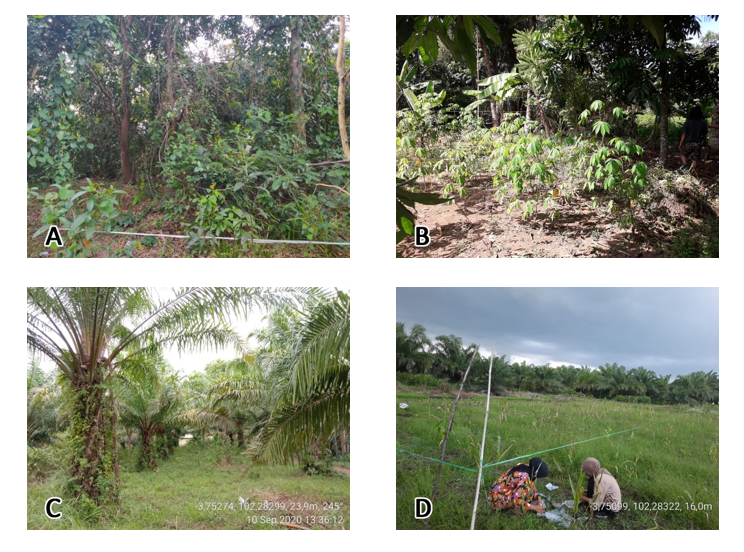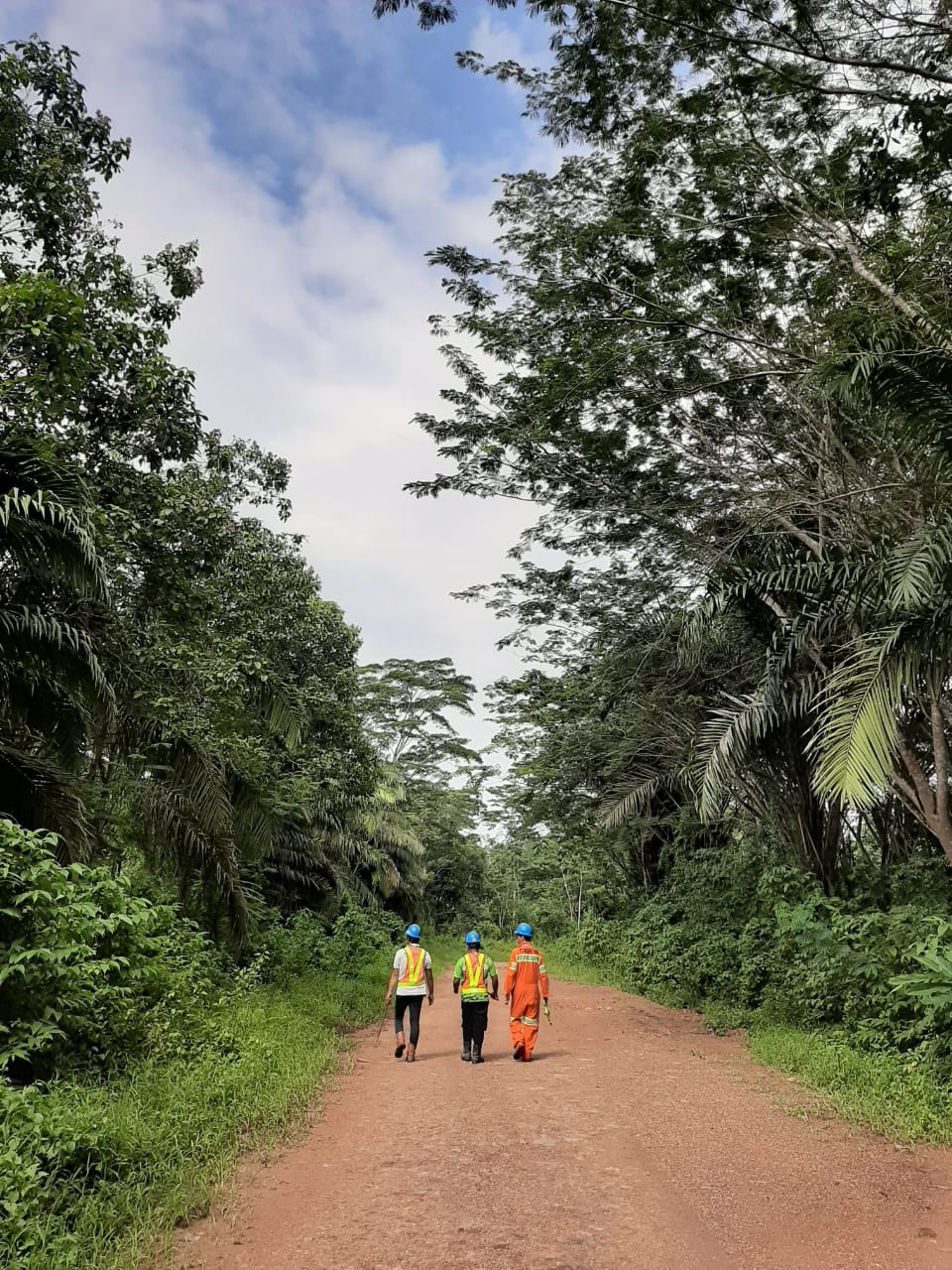Moisture Content and Absorption Levels of Carbon Dioxide in Binuang Bini (Octomeles sumatrana Miq) Trees For Climate Change Management
Abstract
Binuang bini (Octomeles sumatrana Miq) is a fast-growing tree with numerous economic benefits, such as the provision of wood for carpentry purposes, building boards, water management, and absorption of carbon dioxide (CO2). Therefore, this tree species has great potential and needs to be included in Reducing Emission from Deforestation and Forest Degradation (REDD)+'s mitigation program to tackle climate change. In its development, REDD+ has made it possible to carry out carbon trading in the world. Therefore, countries capable of performing protective functions and carry out reforestation, afforestation, and restoration, have the opportunity to be involved in world carbon trading. This study aims to determine the moisture content and carbon absorption rate of Binuang bini trees as a first step to regulate the allometric equation using destructive and laboratory analysis. The results show that the water content in the roots, leaves, as well as the base, middle, and tip of the stem were: 73.69%, 68.39%, 65.59%, 61.22%, and 66.26%, respectively. Furthermore, the sample test results indicate a very close relationship between carbon concentration and absorbance in the O. sumatrana tree with a simple linear regression equation: Y = 0.002X + 0.0593 with R2 = 0.9896. Therefore, this regression equation can be used to calculate the carbon concentration sample for the O. sumatrana tree fraction. The carbon content in 3 tree samples with a breast height diameter of 9.24 cm, 10.08 cm, and 11.68 cm was 2,585 kg. 2,913 kg, and 4,654 kg, respectively. In addition, the carbon sequestration for each tree diameter per year is 1.581 kg year-1, 1,782 kg year-1and 2,847 kg year-1, respectively.
References
[ASTM D143] American Society for Testing and Materials. D143. (1994). Standard methods of testing small clear samples of timber. American Society for Testing and Materials-ASTM. Annual Book of ASTM, 94(Reapproved), 31. Retrieved from http://file.yizimg.com/175706/2011090722382624.pdf
Brown, S., & Iverson, L. R. (1992). Biomass estimates for tropical forests. World Resource Review, 4(3), 366–384.
Chairul, Muchktar, E., Mansyurdin, M, T., & Indra, G. (2016). The structure of vegetation density and the estimation of carbon content in some conditions of forest in Siberut Island, West Sumatera. Journal of Biological Sciences, 3(1), 15–22.
Chang, K. H., Lou, K. R., & Ko, C. H. (2019). Potential of bioenergy production from biomass wastes of rice paddies and forest sectors in Taiwan. Journal of Cleaner Production, 206, 460–476. https://doi.org/10.1016/j.jclepro.2018.09.048
Chave, J., Réjou-Méchain, M., Búrquez, A., Chidumayo, E., Colgan, M. S., Delitti, W. B. C., …, & Vieilledent, G. (2014). Improved allometric models to estimate the aboveground biomass of tropical trees. Global Change Biology, 20(10), 3177–3190. https://doi.org/10.1111/gcb.12629
Duncanson, L. I., Niemann, K. O., & Wulder, M. A. (2010). Estimating forest canopy height and terrain relief from GLAS waveform metrics. Remote Sensing of Environment, 114(1), 138–154. https://doi.org/10.1016/j.rse.2009.08.018
Estornell, J., Ruiz, L. A., Velázquez-Martí, B., & Fernández-Sarría, A. (2011). Estimation of shrub biomass by airborne LiDAR data in small forest stands. Forest Ecology and Management, 262(9), 1697–1703. https://doi.org/10.1016/j.foreco.2011.07.026
Frazer, G. W., Magnussen, S., Wulder, M. A., & Niemann, K. O. (2011). Simulated impact of sample plot size and co-registration error on the accuracy and uncertainty of LiDAR-derived estimates of forest stand biomass. Remote Sensing of Environment, 115(2), 636–649. https://doi.org/10.1016/j.rse.2010.10.008
García, M., Saatchi, S., Ustin, S., & Balzter, H. (2018). Modelling forest canopy height by integrating airborne LiDAR samples with satellite RADAR and multispectral imagery. International Journal of Applied Earth Observation and Geoinformation, 66, 159–173. https://doi.org/10.1016/j.jag.2017.11.017
Hairiah, K., Sitompul, S. M., & Nooordwijk, M. N. P. C. (2001). Methods of sampling for sampling above and below-ground organic pools. IC-SEA Report No. 6: Modelling Global Change Impacts on the Soil Environment, 1–31.
Hairiah, K., & Rahayu, S. (2007). Pengukuran karbon tersimpan di berbagai macam penggunaan lahan. World Agroforestry Centre, 77.
Huy, B., Kralicek, K., Poudel, K. P., Phuong, V. T., Khoa, P. V., Hung, N. D., & Temesgen, H. (2016). Allometric equations for estimating tree aboveground biomass in evergreen broadleaf forests of Viet Nam. Forest Ecology and Management, 382, 193–205. https://doi.org/10.1016/j.foreco.2016.10.021
Indonesian REDD+ Task Force. (2012). REDD+ national strategy. Jakarta: Indonesian REDD+ Task Force.
Indrajaya, Y. (2012). Cadangan karbon hutan bekas tebangan pembalakan berdampak rendah dan konvensional di Kalimantan Timur: Studi kasus di Hutan Malinau. Jurnal Penelitian Sosial dan Ekonomi Kehutanan, 9(1), 21–30. https://doi.org/10.20886/jpsek.2012.9.1.21-30
Kailola, J. (2006). Sifat fisik beberapa jenis kayu unggulan asal Tobelo menurut ketinggian dan kedalaman batang. Agroforestry Padamara, 1(1), 5–12.
Kailola, J., Simanjuntak, R., & Punyia, K. (2019). Kandungan kadar air (H2O) dari jenis kayu jati (Tectona grandis) dan kayu sengon (Paraserianthes falcataria) asal Tobelo Kabupaten Halmahera Utara. Agrikan: Jurnal Agribisnis Perikanan, 11(2), 311–316. https://doi.org/10.29239/j.agrikan.12.2.311-316
Ketterings, Q. M., Coe, R., Van Noordwijk, M., Ambagau’, Y., & Palm, C. A. (2001). Reducing uncertainty in the use of allometric biomass equations for predicting above-ground tree biomass in mixed secondary forests. Forest Ecology and Management, 146(1–3), 199–209. https://doi.org/10.1016/S0378-1127(00)00460-6
Khan, M. N. I., Islam, M. R., Rahman, A., Azad, M. S., Mollick, A. S., Kamruzzaman, M., ..., & Knohl, A. (2020). Allometric relationships of stand level carbon stocks to basal area, tree height and wood density of nine tree species in Bangladesh. Global Ecology and Conservation, 22, e01025. https://doi.org/10.1016/j.gecco.2020.e01025
Krisnawati, H., Adinugroho, W. C., & Imanuddin, R. (2012). Monograf model-model alometrik untuk pendugaan biomassa pada berbagai tipe ekosistem hutan di Indonesia. Bogor: Pusat Penelitian dan Pengembangan Konservasi dan Rehabilitasi
Littlefield, J. A., Marriott, J., Schivley, G. A., & Skone, T. J. (2017). Synthesis of recent ground-level methane emission measurements from the U.S. natural gas supply chain. Journal of Cleaner Production, 148, 118–126. https://doi.org/10.1016/j.jclepro.2017.01.101
Lugo, A. E., & Brown, S. (1986). Steady state terrestrial ecosystems and the global carbon cycle. Vegetatio, 68, 8390.
Luo, S., Wang, C., Xi, X., Nie, S., Fan, X., Chen, H., ..., & Zhou, G. (2019). Estimating forest aboveground biomass using small-footprint full-waveform airborne LiDAR data. International Journal of Applied Earth Observation and Geoinformation, 83, 101922. https://doi.org/10.1016/j.jag.2019.101922
Mardiatmoko, G. (2018). From forest biomass to carbon trading. In E. Jacob-Lopes, & L. Q. Zepka (Eds.), Renewable resources and biorefineries. IntechOpen. https://doi.org/10.5772/intechopen.80395.
Mardiatmoko, G., Kailola, J., Simanjuntak, R., & Kastanya, A. (2020). The rate of absorption of carbon dioxide and moisture content in linggua (Pterocarpus indicus Willd.) for climate change management. Ecology, Environment and Conservation, 26, S415–S422
Martawijaya, A., Kartasujana I, & Kadir K, P. S. A. (2005). Atlas kayu Indonesia (Edisi 1). Bogor: Badan Penelitian dan Pengebangan Kehutanan.
Nuraeni, Y., Anggraeni, I., & Bogidarmanti, R. (2016). Identifikasi rayap benuang bini (Octomeles sumatrana Miq) di KHDTK Haurbentes. Jurnal Hutan Pulau-Pulau Kecil, 1(2), 9296. https://doi.org/10.30598/jhppk.2016.1.2.92
Nurtjahjawilasa, Duryat, K., Yasman, I., Septiani, Y., & Lasmini. (2013). Konsep REDD+ dan implementasinya. (A. Soekadis, D. Marthinus, W. Wardojo, & R. Bukhari, Eds.). Jakarta: The Nature Conservancy Indonesia Program.
Quegan, S., Le Toan, T., Chave, J., Dall, J., Exbrayat, J. F., Minh, D. H. T., ..., & Williams, M. (2019). The European space agency BIOMASS mission: Measuring forest above-ground biomass from space. Remote Sensing of Environment, 227, 44–60. https://doi.org/10.1016/j.rse.2019.03.032
Randrianasolo, Z. H., Razafimahatratra, A. R., Razafinarivo, R. N. G., Randrianary, T., Rakotovololonalimanana, H., Rajemison, A. H., ..., & Ramananantoandro, T. (2019). Which allometric models are the most appropriate for estimating aboveground biomass in secondary forests of Madagascar with Ravenala madagascariensis? Scientific African, 6, e00147. https://doi.org/10.1016/j.sciaf.2019.e00147
Ravanini, F., Ferreira, R., & Ribeiro, R. (2020). Brazil’s forest restoration, biomass and carbon stocks: A critical review of the knowledge gaps. Forest Ecology and Management, 462, 117972. https://doi.org/10.1016/j.foreco.2020.117972
Silooy, G. A. (1983). Variabilitas sfat mekanik pada kondisi kering udara dari jenis kayu makila (Litsea anggulata BI) dan lingua (Pterocarpus indicus Will) asal Kecamatan Waipia Seram Selatan Kabupaten Dati II Maluku Tengah [undergraduate thesis]. Ambon: Universitas Pattimura.
Singh, K. K., Chen, G., McCarter, J. B., & Meentemeyer, R. K. (2015). Effects of LiDAR point density and landscape context on estimates of urban forest biomass. ISPRS Journal of Photogrammetry and Remote Sensing, 101, 310–322. https://doi.org/10.1016/j.isprsjprs.2014.12.021
Stas, S. M., Rutishauser, E., Chave, J., Anten, N. P. R., & Laumonier, Y. (2017). Estimating the aboveground biomass in an old secondary forest on limestone in the Moluccas, Indonesia: Comparing locally developed versus existing allometric models. Forest Ecology and Management, 389, 27–34. https://doi.org/10.1016/j.foreco.2016.12.010
Suhartati, Rahmayanti, S., Junaedi, A., & Nurrohman, E. (2012). Sebaran dan persyaratan tumbuh jenis alternatif penghasil pulp di wilayah Riau (N. Mindawati, P. Pamoengkas, U. Sutisna, & A. P. Tampubolon, Eds.). Jakarta: Badan Penelitian dan Pengembangan Kehutanan.
Walkley, A., & Black, I. A. (1934). An examination of the degtjareff method for determining soil organic matter, and a proposed modification of the chromic acid titration method. Soil Science, 37(1), 29–38. https://doi.org/10.1097/00010694-193401000-00003
Zhang, H., Deng, Q., Hui, D., Wu, J., Xiong, X., Zhao, J., ..., & Zhang, D. (2019). Recovery in soil carbon stock but reduction in carbon stabilization after 56-year forest restoration in degraded tropical lands. Forest Ecology and Management, 441, 1–8. https://doi.org/10.1016/j.foreco.2019.03.037
Authors

This work is licensed under a Creative Commons Attribution 4.0 International License.
Jurnal Manajemen Hutan Tropika is an open access journal which means that all contents is freely available without charge to the user or his/her institution. Users are allowed to read, download, copy, distribute, print, search, or link to the full texts of the articles in this journal without asking prior permission from the publisher or the author. This is in accordance with the Budapest Open Access Initiative (BOAI) definition of open access.








